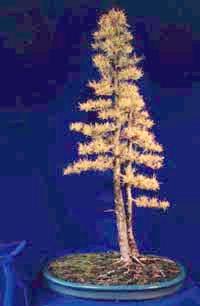|
 This twin trunk Eastern larch, Larix
laricina, was found on a bog in Northern Michigan and collected
in the fall of 1985 and placed into a growing bed. It was potted
into this container and has remained there for the last 19 years.
It is repotted every two or three years. At the time of collection
it was approximately 85 years old . This was determined by a
ring count performed on the base of the tree. This twin trunk Eastern larch, Larix
laricina, was found on a bog in Northern Michigan and collected
in the fall of 1985 and placed into a growing bed. It was potted
into this container and has remained there for the last 19 years.
It is repotted every two or three years. At the time of collection
it was approximately 85 years old . This was determined by a
ring count performed on the base of the tree.
One summer a finch placed
her nest and raised 4 young in this tree! What a nice affirmation
when a wild bird accepts the tree as its home.
Larches are deciduous conifers
and their needles turn yellow in the fall and then are shed.
The new leaves appear in late spring and some years small seed
cones are formed.

Although the Eastern Larch
is often found growing on bogs, they prefer to grow in normal
bonsai soil and receive normal watering. They are extremely cold
hardy and will not have any winter kill. They will not break
back on old wood so do not trim them back beyond the needles.
Wire the tree in spring
before the needles elongate as this is much easier than trying
to wire when the foliage is out, and the growing points are easily
damaged. Larches take wiring well and seem to stay where they
are wired.
This larch is 44 inches
tall. |

